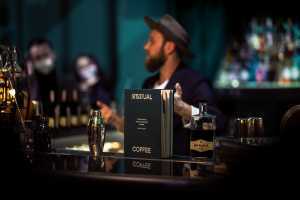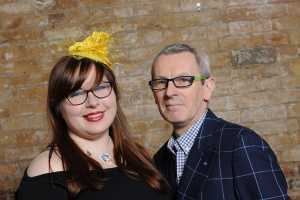It was behind the stick at Soho Brasserie in 1983 where the universally loved espresso martini was born. It was created by Dick Bradsell, a titan of the bar industry whose then-called ‘Vodka Espresso’ was made up of vodka, coffee liqueur, sugar and shot of espresso.
Dick Bradsell’s influence on the cocktail culture – not just of London, but around the world – cannot be overstated. His New York Times obituary describes him as “the father of the cocktail revival” with his legacy taking hold in 1990s London and continuing over two decades later.
“By the turn of the century,” it continues, “his influence was felt not just in London but throughout Britain and as far away as Australia, thanks to bartenders who were either trained by him directly or inspired by his cocktail creations.”
Bradsell created a handful of drinks that have gone on to be modern classics – the blackberry-flecked bramble, for example, is arguably as much staple of cocktail bars and recipe books as the classic cocktails of the 1920s – but none have crossed over to quite the extent as the espresso martini. Nearly 40 years since its creation in 1983, it’s reached the giddy heights of many a most-popular-cocktail lists, available to order both at the best bars in the world and probably your local gastropub, too.
The meteoric rise of Bradsell’s creation in recent years – no doubt linked to the UK’s increasing love of quality coffee across a similar timeline – has also given way to other coffee creations coming out of the shadows. So with that said, and with the espresso martini having achieved near ubiquity, what’s next for coffee’s journey behind the bar, and is there another hero cocktail in waiting?
The Harlem Shake cocktail, the recipe for which can be found in Spiritual Coffee
The coffee-infused White Russian in Spiritual Coffee
Out of the shadows
For a trustworthy source of information on the past, present and future of coffee in cocktails, Martin Hudak – brand ambassador for all-conquering Austalian coffee liqueur Mr Black, as well as proprietor for some of Australia’s best bars, such as Maybe Sammy – is a good place to start. “We’ve seen a huge trend where coffee is more and more respected and appreciated by professionals,” he says. “More venues are adding more coffee cocktails to their drinks lists to diversify their menu and be slightly different.”
When it comes to coffee cocktails, Hudak is – currently – the oracle, having just published his book dedicated to the mighty bean and its use in drinks, Spiritual Coffee. “In the beginning of the first lockdown, I had spare time to research and delve deep into well-known coffee cocktails,” he explains, “but there were so many different stories and information that wasn’t trustworthy enough. I always knew there was much more to coffee cocktails than what we know, but till now there hasn’t been a tangible publication where you could find it all. From their history to the present and future, I wanted to write the first bible of coffee cocktails.”

Martin Hudak at the launch of Spiritual Coffee
Of course, coffee in cocktails isn’t anything new. As Hudak points out, it was common in as far as back as the 17th century. In French cafés, high society would enjoy coffee served with brandy or eau de vie in a drink that was called the Café Gloria – the holy trinity of coffee, sugar and spirit – while in 1930s Hollywood, rum was being mixed with coffee, and plenty more in between. Hudak’s book also talks about coffee’s use in mixed drinks across history, from Union Soldiers in the American civil war to the tiki explosion of the 1930s.
As for the espresso martini, while Bradsell’s role as its creator is undisputed, its creation myth can’t make the same claim. The story goes that an unnamed model and socialite – usually assumed to be either Kate Moss or Naomi Campbell – walked into the bar and asked for a drink that would “wake me up and fuck me up.” Bradsell looked at the espresso machine and improvised the drink on the spot.
As Hudak writes in Spiritual Coffee, the truth is probably more prosaic – Bradsell’s station was next to the coffee machine, and he probably stumbled upon it during commonplace experimentation with drinks (not to mention the reported timelines don’t add up for either Moss or Campbell).
The story goes that an unnamed model and socialite walked into the bar and asked for a drink that would “wake me up and fuck me up”
That the apocryphal origin story becoming enshrined in bartending folklore, though, speaks to both the cultural footprint of the drink, its fun-time appeal, and the towering reputation of its creator. “He was always proud of it,” Bradsell’s daughter Bea, who works for drinks agency The Drinks Cabinet, tells me of her father’s love for his creation. ““He always wanted to create the party. He believed in the power of conversation and dancing and the Espresso martini was a big part of that.”
Another historic coffee cocktail that’s been popping up across London in recent years, though, is the Irish coffee, usually a mix of booze, coffee and sweetener, served hot with a floated cream top, but with innumerable subtle variations. “It’s weird to say it’s a trendy drink, but Irish coffees are definitely growing,” says Bea Bradsell.

Drinks expert Bea Bradsell with her father, the late, great bartender Dick Bradsell
While the likes of London’s Homeboy, Swift and Sun Tavern have become known for turning out excellent versions of this post-Prohibition number (and I’d be remiss not to mention the legendary Dead Rabbit bar in New York, which also put this cocktail back on the international map), new pub and bar The George on Great Portland Street serves a classic of the genre. In fact, The George’s version recently took top billing during a quest I undertook with an expert team to find the best version of the drink in London. With its expertly floated cream, and a lovely mix of Jameson Stout edition, homemade Guinness reduction and a generous dusting of nutmeg, this version, served in the upmarket pub, is testament to the allure of bartenders to take coffee cocktails seriously. Hudak also lists the recipe for a cold version of the classic in Spiritual Coffee.
Classic curveballs
But what about using coffee in the non-coffee classics? Well, who better to ask than the 2018 & 2019 World Coffee in Good Spirits Champion, Dan Fellows, who has a Youtube channel (Dan Fellows Coffee Cocktails) where he showcases coffee in myriad cocktails. “Pretty much any classic cocktail can pair well with coffee, because coffee itself can bring so many different flavours to the table,” he explains.
“If we take the old fashioned’s loose template as a starting point [whisky, sugar, bitters] imagine adding a coffee that tastes of pineapple and toasted coconut and pairing that with a tropical, toffee and banana-forward rum cask whisky, or a coffee that tastes like strawberry and blood orange paired with a big, vanilla-forward bourbon.” This is a good place to point out that like spirits, different coffees can, of course, present different and nuanced flavour profiles, from fruity and earthy to citrus and much, much more. “Whatever cocktail you love, think about what sort of flavours would complement them and consider choosing a coffee that brings these characteristics,” he adds.
Pretty much any classic cocktail can pair well with coffee, because coffee itself can bring so many different flavours to the table
“Remember that coffee doesn’t always have to be the dominant flavour; even a very small amount can bring amazing complexity to a drink.” Hudak agrees, namechecking drinks like the Coffee Negroni and a Cold Fashioned as examples of where coffee can be used in the classics. It’s something that café and bar group Grind showcases on its booze menu, with a five-strong section dedicated to coffee cockails. Its Espresso Old Fashioned adds its house blend syrup to Wild Turkey bourbon and Angostura bitters; while its Coffee Negroni mixes Grind filter coffee with East London Liquor Company gin, Campari, vermouth and orange.
Time for a riff
Riffs on the classic espresso martini also deserve a mention. My personal favourite has to be the Champagne & Co at Blue Bar at The Berkeley hotel in Knightsbridge. It combines coffee liqueur, Guinness, Avallen calvados, demerara sugar and Laurent-Perrier Champagne. It’s at most a distant cousin of the espresso martini, drawing inspiration from the Champagne Cocktail and Black Velvet to create a distinct take on the modern classic.
“I love coffee,” head bartender Andrea Melis tells me. “I’m into the different flavour perceptions of each kind of coffee, so what we decided to do was to create a champagne cocktail and flavour it with coffee.” As with a black velvet (champagne and stout) the Champagne & Co combines the grounding of the Guinness flavours with those of the champagne, while the coffee liqueur matches the fruitiness of the calvados. A foam on top completes the ‘almost espresso martini’ look too.
Pouring the Irish Coffee at The George pub
The final touch: a dusting of nutmeg
Elsewhere and Kingsland Road’s A Bar With Shapes for a Name serves a short, bottled version of an espresso martini, while The Hoxton is opening a new coffee bar which will be serving coffee by day and nitro espresso martinis by night. “Cocktails are going to be aperitivo style,” head bartender Tom Byrne tells me. “We’ve partnered with Grey Goose to do the espresso martinis on tap showcasing cold brew for coffee cocktails and nitrogen using the same process as pouring Guinness.”
Further down the line, Byrne is looking to introduce pour over coffees and filters to make the likes of Irish Coffees with flavoured cream and potentially swapping out whisky for the likes of calvados.
Brew it yourself
Of course, leaving it to the pros is one option, but if you want to experiment at home, there are plenty of easy cocktails that can be reproduced with careful attention to ingredients. For Hudak, where your coffee is from is paramount. “Make sure you know where your coffee is coming from and when it was roasted,” he advises. “Freshness is very important as it will reflect the final taste. Focus on 100% speciality grade arabica coffee, roasted lightly by your local cafe or roastery.
Try to have conversations with baristas and ask them for advice on how to grind it and brew it at home if you want to achieve specific results. Once you have coffee at home, store it in an airtight container as oxygen is the biggest enemy for freshness of your coffee.”
Bea Bradsell is in favour of mixing coffee with tonic – a drink that’s big in Australia and a nice idea for those after something non alcoholic. Byrne suggests something like a coffee corretto, an Italian drink using a shot of espresso with a spirit like grappa or brandy, or even in a whisky highball with some sugar and a slice of orange.
However you drink it, whether you’re enjoying an Irish coffee at The George, an espresso martini at All Bar One, or playing around at home, one word of advice: give a toast to Dick Bradsell and his ingenuity for making coffee cocktails in the UK cool again and unlocking a world of flavour.
